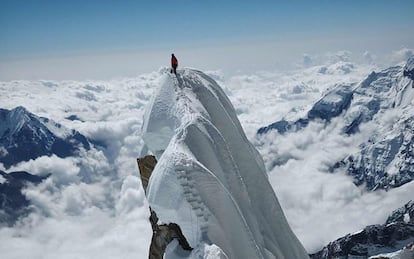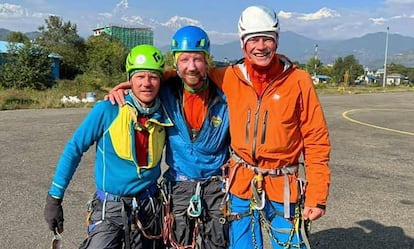Annapurna III: The great mountaineering challenge of the 20th century is finally conquered
Three Ukrainian climbers managed the first ascent of the mountain’s southeast ridge, a unique feat that has defied 40 years of attempts

Annapurna (8,091 meters), the first mountain standing over 8,000 meters high to be conquered by man – Maurice Herzog and Louis Lachenal made the first ascent in 1950 – hid other Annapurnas in its shadow, none of which are as severe and complex as the southeast ridge of Annapurna III (7,555 meters). This autumn, it was finally climbed. Marked as the great objective of mountaineering in the 20th century, Annapurna III had been visited by some of the most famous names in the business, who made their attempts in dribs and drabs over the last 40 years. Rather than merely a route that someone should climb in an indeterminate future, it represented something more like a half-finished canvas that no botched job should be allowed to blemish; the climber Conrad Anker wrote an article almost pleading whoever managed to overcome the southeast ridge to do so in good style, cleanly and by the fairest means possible.
Previous attempts followed Anker’s request. In 1981, three renowned British climbers – Nick Colton, Steve Bell and Tim Leach – reached a height of 6,500 meters on this ridge. They knew how to acknowledge their limits and had the wherewithal to abandon their attempt. They had opened the route for others to follow but the difficulties they faced were so unbearable that their minds were looking down even though their eyes were fixed in the opposite direction. Interviewed by Ed Douglas in 2012 for Alpinist magazine, the three climbers admitted that after that experience they had never been able to climb again with such commitment.
It has been a wonderful season in the Himalayan mountains of Nepal: many adventurous teams and very favorable conditions due to the impact of climate change have led to several impressive first ascents, including the northeast pillar of Tengkangpoche (6,487 meters) and the virgin north face of Chamlang (7,319 meters). But none have generated as much admiration as the conquest of Annapurna III by Ukrainian climbers Nikita Balabanov, Mikhail Fomin and Viacheslav Polezhaiko.

In 2019, the trio learned the necessary strategy to calculate the line, where great figures of climbing Hansjörg Auer and David Lama (who were killed in an avalanche in 2019 alongside Jess Roskelley) were thwarted in 2016, and a British expedition led by Nick Bullock was turned back in 2010. Neither of these expeditions managed to exceed the height reached in 1981. The Ukrainian expedition told the Explorers Web website that they had leaned on their reserves of patience to achieve their feat on one of the toughest mountain faces in the Himalayas.
Alpine style: strength, technique and self-sufficiency
Nick Bullock wrote in 2010: “It only took a few days to realize that the Southeast Ridge was an incredibly dangerous, if not suicidal objective for an Alpine-style ascent.” The Alpine-style fits in with the pleas of Conrad Anker: it consists of leaving base camp as though you were climbing near home, that is to say with everything you need to climb and sleep on the mountain if necessary. Of course, one objective is not the same as another: it is still common for big expeditions in the eight-thousanders (mountains over 8,000 kilometers) to employ sherpas to carry loads, set up high-altitude camps and fix lines for climbers, but the Alpine-style eschews all of this and requires climbers to be as strong as they are technical and, above all, self-sufficient.
Each carrying 40 kilos of equipment on Annapurna III, the Ukrainian trio calculated that they would need 12 days to climb the mountain and descend, taking into account they had little idea where they would be descending from given that retracing their steps along the line of ascent was impossible due to its tremendous technical difficulty. In the end, they spent 18 days on the mountain, sustaining themselves with one and a half energy bars per day for the final six days.
Balabanov, Fomin and Polezhaiko baptized the route Patience. They lost an average of 13 kilos between them and only suffered some light frostbite on their fingers, the toll of a blind descent on the southern slope of the mountain while being buffeted by ferocious gusts of wind. At the point of collapse and with no chance of making it back to their base camp, they were transported to Kathmandu by helicopter.
Non-professionals and unsponsored
As they told several media outlets on their safe return, the decision-making process in situations of extreme risk or indecisiveness was key to their perseverance. At those junctures, the uneven number helped to simplify debate: when two opposing opinions emerged at moments of extreme stress, the voice of the third team member decided the balance. That was how they were able to pick their way through terrifying areas of loose snow, stretches of corroded rock that crumbled like pastry under their boots, blocks that threatened to fall like bombs on the two securing the first rope and gusts of wind reaching 70 kilometers per hour.
None of the three is a professional climber and they have no sponsorship deals, only receiving certain forms of help from time to time. When compared with the commercial eight-thousander expeditions taking the habitual routes, it can only be concluded that higher does not equate to more difficult, only to higher, and that above all something that once qualified as alpinism has now changed. They felt the lure of climbing an eight-thousander by an unprecedented route: technical climbing and extreme altitude. Now that they have climbed the greatest challenge of the 20th century in the 21st century, perhaps they can take up the big challenge of the next century.
Tu suscripción se está usando en otro dispositivo
¿Quieres añadir otro usuario a tu suscripción?
Si continúas leyendo en este dispositivo, no se podrá leer en el otro.
FlechaTu suscripción se está usando en otro dispositivo y solo puedes acceder a EL PAÍS desde un dispositivo a la vez.
Si quieres compartir tu cuenta, cambia tu suscripción a la modalidad Premium, así podrás añadir otro usuario. Cada uno accederá con su propia cuenta de email, lo que os permitirá personalizar vuestra experiencia en EL PAÍS.
¿Tienes una suscripción de empresa? Accede aquí para contratar más cuentas.
En el caso de no saber quién está usando tu cuenta, te recomendamos cambiar tu contraseña aquí.
Si decides continuar compartiendo tu cuenta, este mensaje se mostrará en tu dispositivo y en el de la otra persona que está usando tu cuenta de forma indefinida, afectando a tu experiencia de lectura. Puedes consultar aquí los términos y condiciones de la suscripción digital.
More information
Archived In
Últimas noticias
Most viewed
- Sinaloa Cartel war is taking its toll on Los Chapitos
- Oona Chaplin: ‘I told James Cameron that I was living in a treehouse and starting a permaculture project with a friend’
- Reinhard Genzel, Nobel laureate in physics: ‘One-minute videos will never give you the truth’
- Why the price of coffee has skyrocketed: from Brazilian plantations to specialty coffee houses
- Silver prices are going crazy: This is what’s fueling the rally










































